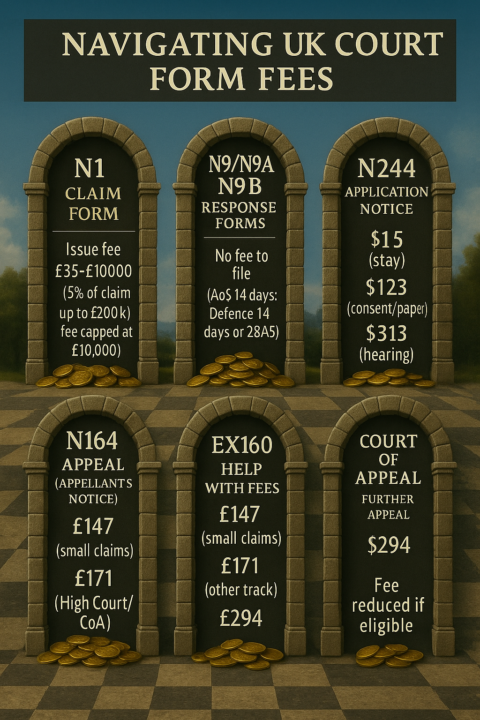Activity
Mon
Wed
Fri
Sun
Oct
Nov
Dec
Jan
Feb
Mar
Apr
May
Jun
Jul
Aug
Sep
What is this?
Less
More
Memberships
Checkmate The Matrix
589 members • $65/m
304 contributions to Checkmate The Matrix
Claim
Back in July 2021, I agreed to make payment to South West Water, (circumstances dictated) I completed payments therfore fulfilling my obligation. A paid in full notification was entered. I did a direct debit indemnity clawback for the payments In 2023. Now in 2025 they want to reinstate the CCJ and have the paid in full notification cancelled. Can they do this? I am thinking that the original application for a CCJ was satisfied. Can they now bring the original claim back into the court?
4 likes • Aug 26
Thanks Graham—this is a nuanced situation, and the member’s instincts are sound. Let’s break it down strategically: ⚖️ Key Facts - 2021: Payments made to South West Water under duress or necessity. - Paid in Full Notification entered—suggesting the CCJ was marked as satisfied. - 2023: Direct Debit Indemnity Claim (clawback) initiated—funds returned. - 2025: South West Water seeks to reinstate the CCJ and cancel the “Paid in Full” status. 🧠 Legal Assessment 1. Was the CCJ legally satisfied? Yes—if the court marked the judgment as “satisfied” following payment, then procedurally, the debt was discharged. This is recorded under CPR 40.9 and reflected on the Register of Judgments. 2. Does the clawback reverse satisfaction? Not automatically. The Direct Debit Indemnity Scheme is a banking remedy—not a legal one. It allows the payer to reclaim funds, but it doesn’t nullify the original obligation unless: - The clawback was legally justified (e.g. fraud, error, or lack of contractual basis) - The creditor failed to challenge it or reassert the debt If South West Water did not dispute the clawback in 2023, they may now be out of time or procedurally barred from reopening the claim. 3. Can they reinstate the CCJ? They cannot simply “reinstate” a satisfied CCJ. They would need to: - Apply under CPR 23 for the judgment to be set aside or varied - Show that the satisfaction was entered in error or based on misrepresentation - Possibly issue a new claim if they argue the clawback created a fresh cause of action But this is procedurally complex and would likely require permission from the court. The original claim cannot just be “revived” without judicial scrutiny. 4. Does the clawback create a new liability? Only if South West Water can prove: - The clawback was unjustified - The original debt remains enforceable - They have not waived their rights by accepting satisfaction If they accepted the “Paid in Full” status and took no action for over a year, they may be estopped from reopening the matter—especially if the member relied on that status to their detriment.
1 like • 7d
@Warren Bell - You're absolutely right to flag this, Graham—this member’s situation is procedurally and legally flawed on multiple fronts. Let’s break it down and map out the next steps with precision. ⚖️ Legal Assessment: CCJ Granted Despite Defence and Payment ✅ 1. Judgment Entered Despite Defence If the member filed a defence and the debt was paid in full, then the court should not have entered judgment unless: The defence was struck out (e.g. for being defective or late) The claimant applied for summary judgment and succeeded The payment was not acknowledged or proven If none of these occurred, the judgment may have been entered in error, which is grounds to set it aside under CPR 13.2 or 13.3. ✅ 2. No Notification or Paperwork Discovering the CCJ via ClearScore rather than official court communication suggests: Improper service of the claim form or judgment Potential breach of CPR Part 6 (service rules) Grounds for setting aside under CPR 13.3(1)(b): “some other good reason why the judgment should be set aside or varied.” ✅ 3. Debt Already Paid If the debt was paid before judgment was entered, then: The judgment should not have been granted The member can apply to set aside the CCJ under CPR 13.2 (mandatory grounds) or 13.3 (discretionary) The court may have failed to process the defence or payment properly—this is a procedural irregularity 🧾 Next Steps for the Member ✅ Step 1: Apply to Set Aside the Judgment Use Form N244 Grounds: Debt paid in full before judgment; defence filed; no paperwork received; judgment entered in error Include a witness statement explaining the timeline and attaching any proof of payment ✅ Step 2: Request Court Records Contact the relevant County Court and request: The claim form The defence submission The judgment order This helps confirm whether the defence was processed and whether the judgment was default or summary ✅ Step 3: Consider Complaint Escalation If the court ignored the complaint, escalate to:
Can Link continue collecting an account that they define as unenforceable?
Help me out with this one... I've been pursuing the Deed of Assignment / GDPR journey with this account of mine. The original creditor was Halifax (now Bank of Scotland), Moorcroft has been involved and not declaring their role. The account was 'sold' to Link Financial. Bank of Scotland have missed the 30 day deadline to reply to my SAR. Strangely when I submitted my SAR to BOS I received a letter very quickly from Link declaring the account was unenforceable. This was followed a week later with the same letter. I asked them to clarify their lawful basis for continuing to process my data and received this letter. What advice can you give me regarding the question of the debt being unenforceable but collection activities and reporting will continue. How does this site with GDPR? Any suggestions for my next step will be greatly appreciated.
1 like • 11d
Absolutely, Graham—this is a textbook case of strategic tension between contractual enforceability and data protection law. Let’s break it down for Paul with precision and tactical clarity: ⚖️ Can Link Collect on an “Unenforceable” Debt? ✅ Legally speaking: - A debt being unenforceable means Link cannot take court action to recover it—typically due to: But unenforceable ≠ extinguished. Link can still request payment, send letters, and report to credit reference agencies—unless doing so breaches GDPR or consumer protection law. 🧠 GDPR Implications: Lawful Basis for Processing Under UK GDPR, Link must have a valid lawful basis to process Paul’s personal data. The most common ones they rely on are: 1 -Lawful Basis - Can It Apply Here? Contractual necessity❌ Not applicable if the debt is unenforceable and Link can’t prove a valid contract 2 - Legal obligation❌ Only applies if they’re complying with a legal duty (e.g. HMRC)—not debt collection 3 - Legitimate interest⚠️ Often claimed—but must be balanced against Paul’s rights and the nature of the debt If the debt is unenforceable and Link cannot prove a valid assignment or contract, their legitimate interest claim becomes shaky—especially if Paul has objected. 📨 Link’s Response Letter: What It Suggests If Link admits the debt is unenforceable but says they’ll continue collection and reporting, they’re likely relying on legitimate interest. But under Article 21 GDPR, Paul has the right to object to processing—especially if it causes distress or reputational harm. 🧾 Next Steps for Paul ✅ 1. Submit a GDPR Objection Notice - Reference Article 21 UK GDPR - State that Link has admitted the debt is unenforceable - Demand cessation of all data processing, including reporting to CRAs - Request deletion under Article 17 (Right to Erasure) if no lawful basis remains ✅ 2. File a Complaint with the ICO - If Link refuses to stop processing, Paul can escalate to the Information Commissioner’s Office - Include: - File a defence (N9B) citing lack of enforceability - Add a GDPR counterclaim for unlawful data processing - Reference Farley v Paymaster [2025] EWCA Civ 1117, which confirms:

💷 Court Fees in Debt Claims – From N1 Claims to N244 Applications to N164 Appeals
When you’re dealing with debt courts, it’s not just the law you’re you need to pay attention to— it’s the fees and forms at every stage. Here’s the full breakdown, so the process isn’t a mystery. 📌 N1 – Issuing the Claim (Claim Form) Paid by the claimant (creditor/debt buyer). - Up to £300 → £35 - £300–£500 → £50 - £500–£1,000 → £70 - £1,000–£1,500 → £80 - £1,500–£3,000 → £115 - £3,000–£5,000 → £205 - £5,000–£10,000 → £455 - £10,000–£200,000 → 5% of claim (capped at £10,000). ⚠️ Debt buyers love bulk-issuing claims — small fees for them, big default CCJs for you if unchallenged. 📌 N9A / N9B – Responding to the Claim - N9A = Admission (admit debt, offer instalments). - N9B = Defence (dispute debt, force proof). ⚠️ Most CCJs happen by default because defendants don’t return N9A/N9B in time. 📌 N244 – Applications (Your Defence Tool) Used to: - Set aside a CCJ. - Stay enforcement (stop bailiffs while appeal pending). - Vary an order (change payment terms). Fees (2025): - £15 → suspend/vary enforcement. - £123 → by consent / without notice. - £313 → on notice with a hearing. 💡 Tip: Tick “decide without a hearing” if possible — saves £190. 📌 N164 – Appeals (Appellant’s Notice) When judgment is wrong in law. Fees (2025): - £147 → Appeal to a Circuit Judge (small claims track). - £171 → Appeal to a Circuit Judge (other tracks). - £294 → Appeal to the High Court. ⚠️ Unlike N244, no cheap paper option. The fee is fixed whether permission is considered on the papers or at a hearing. 📌 EX160 – Fee Remission If you’re on a low income or benefits, you may get your court fees reduced or waived. - Apply using EX160 – Help with Fees. - Based on income/savings. - Always worth checking before you pay. 📌 If Your Appeal Fails - If a Circuit Judge refuses permission on the papers, you can request an oral renewal hearing (normally no extra fee). - If permission is still refused, the only option is a further appeal to the Court of Appeal. - Fee (2025): £294. - This is a brand-new appeal — higher court, higher cost.

1-10 of 304
@graham-hughes-8716
My name is Graham, a father to three daughters and grandfather to six granddaughters, looking to secure a quiet stress free life.
Active 3d ago
Joined Nov 10, 2024
Powered by






